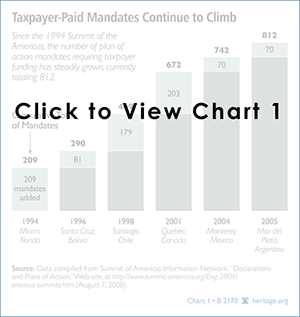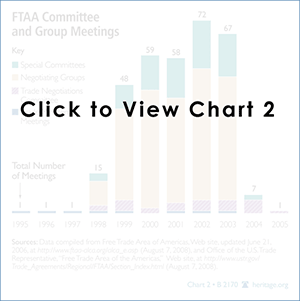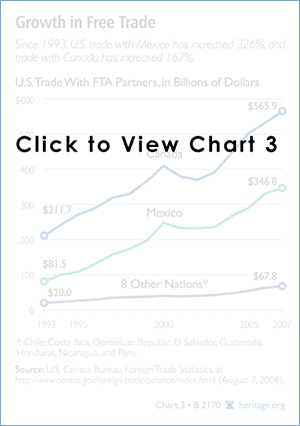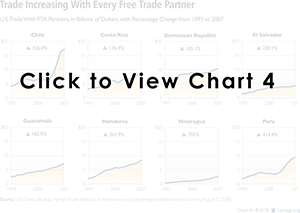A presidential-level summit process to consolidate democracy and facilitate negotiations for a Free Trade Area of the Americas (FTAA) agreement was a bright and noble vision when President George H.W. Bush proposed it in 1990. However, prospects for an FTAA have since dimmed, subverted by myopic special interests, the rise of hard-left opponents of market-based democracy, Brazilian and Argentinean nationalism, U.S. and EU agribusiness and labor union lobbyists, and international bureaucrats from an alphabet soup of multilateral agencies. Regrettably, this economic retreat from free trade has been mirrored by a political reversion to leftist-populist, autocratic regimes in some Latin American countries.
The 2005 Summit of the Americas at Mar del Plata, Argentina, the most recent summit, was a disaster for the Bush Administration. It was disrupted by an unholy alliance of anti-U.S., anti-free trade, and anti-globalization groups and leaders, including Hugo Chavez, Evo Morales, and Néstor Kirchner, and other "21st century socialists." They will doubtlessly attempt to hijack the attention of the world media at the next Summit of the Americas, which is planned for April 2009 in Port of Spain, Trinidad and Tobago.
The Trinidad Summit is currently the first multilateral meeting of Latin American heads of state on the next President's calendar. Such an event should be a forward-looking and upbeat moment for U.S.–Latin American relations, not another public relations disaster.
The FTAA itself is a dead letter, partially replaced by a series of free trade agreements (FTAs) with U.S. friends along the Pacific Rim of the Americas. Yet the "summit process" lurches along, providing few tangible benefits except to the international bureaucrats who use it as an excuse for international travel and a vehicle to obtain taxpayer funding for their programs.
The potential risks for the U.S. at the Trinidad Summit outweigh any potential advantages. Instead, the U.S. should pull the plug on the Summit of the Americas. In its place, the Bush Administration should announce a Western Hemisphere Trade Summit for the U.S.'s FTA partners, including Panama and Colombia, and schedule the summit for early in 2009. This would make the next President's first meeting with Latin American leaders a gathering of U.S. friends and trading partners—a summit free from any preconditions that are currently associated with the Summit of the Americas.
The FTAA: A Great Idea
President George H. W. Bush stirred imaginations in the Western Hemisphere at the end of the Cold War in 1990 when he proposed a vast "free trade zone stretching from the port of Anchorage [Alaska] to the Tierra del Fuego,"[1] the southern tip of South America. Bush's Enterprise for the Americas Initiative envisioned "free trade throughout the hemisphere, greater investment, debt relief, and increased environmental cooperation"[2] and kicked off the U.S. government's ultimately successful effort to negotiate and implement the North American Free Trade Agreement (NAFTA). An FTAA agreement was to be a follow-on to NAFTA.
In the early 1990s, Latin American governments eagerly undertook some of the reforms outlined in the "Washington Consensus," which was a series of policy steps needed for an economy to enter the modern world—macroeconomic discipline, microeconomic liberalization, and participation in the global economy—that was put together in 1989 by International Monetary Fund economist John Williamson.[3] Latin leaders followed at least some of the advice: limiting spending, opening their economies to foreign trade and investment, privatizing state-owned enterprises, and raising interest rates to cure the hyper-inflation that had dogged much of the hemisphere during the "lost decade" of the 1980s, when much of the region was ruled by dictatorships.[4] In the heady atmosphere of those early successes, heads of state met in Miami in December 1994 at the first Summit of the Americas, where they launched negotiations on an FTAA.[5]
Losing the FTAA Vision
The Miami Summit in 1994 was a success. The 34 democratically elected heads of state who attended formally approved the goal of creating a FTAA by 2005, as proposed by President Bush and later adopted by President Bill Clinton. Yet beginning in Miami, the U.S. began to lose control of the agenda and the vision of an FTAA began to blur.
Led by the Organization of American States (OAS), a gaggle of international organizations gradually hijacked the agenda and eventually obscured the primary goal of establishing a hemispheric free trade zone. Instead of focusing on the FTAA, these international bureaucrats created the Summits of the Americas process with its Declarations of Principles and its Plans of Action and institutionalized a ministerial-level Summit Implementation Review Group (SIRG).
The SIRG's principal aim seems to be the extraction of official promises from heads of state to provide taxpayer funds for a seemingly never-ending list of social engineering, environmental, and income redistribution programs. These programs would be executed by their various international agencies and nongovernmental organizations. Some programs have overpromised. Others emphasize statist and big government approaches to development and problem solving. Not enough of them center on increasing trade, investment, entrepreneurship, and job creation through the private sector.[6] This dichotomy is demonstrated in Charts 1 and 2. An explosion of taxpayer-funded summit "mandates" (now numbering 812) in Chart 1 is negatively correlated with the collapse of FTAA negotiating sessions.
Summit Mandates for Statist Development
The mandates and action plans that emerged at the 2005 Mar del Plata Summit provide convincing evidence that the summit process has shifted away from advancing free trade as the principal means of economic development to giving government an ever-expanding primary role. The mandates and action plans cover a broad range of areas, including:
- Public education. "We will strive for quality public education at all levels.... We note with satisfaction the suggestion of the Ministers of Education that our governments explore innovative forms of increasing financing for education with international financing institutions, such as debt swaps for investment in education."[7]
- Sustainable development and the environment. "We are committed to building…[a] public policy framework for integral and sustainable development that can reduce poverty and inequality, advance human health, and protect the environment in harmony with international environmental agreementsto which we are all party, including those that address endangered and migratory species and wildlife, wetlands, desertification, ozone depleting chemicals, and climate change.[8]
- Labor policies. "We recognize the vital contributions of Ministries of Labor to the achievement of the objectives of the Fourth Summit of the Americas…and to the promotion of decent work and policies that encourage investment and economic growth with equity. We are committed to strengthening them with the goal of ensuring that they have sufficient national budgetary and technical resources to carry out their duties in an efficient and effective manner."[9]
- Infrastructure. International organizations commit"[t]o foster multilateral cooperation from development banks in order to identify and provide financing for national and regional infrastructure projects, in particular those designed to promote sustainable development, generate employment, and fight poverty."[10]
- Science and technology. International organizations commit "[t]o request the appropriate multilateral organizations to strengthen technical and financial cooperation activitiesaimed at pursuing this goal and at the development of national innovation systems."[11]
- Job creation. International organizations commit "[t]o request the ILO [International Labour Organization] to extend its technical assistance and support to countries (governments, organizations of employers, and workers)in their efforts to promote the creation of more and better jobs, especially through the strengthening and development of micro, small, and medium-sized companies."[12]
- Agriculture. International organizations commit "[t]o request Inter-American Institute for Cooperation on Agriculture (IICA) and ECLAC [Economic Commission for Latin America and the Caribbean] to continue with their efforts to develop an information system for the follow-up and evaluation of the AGRO 2003–2015 Plan, and the other members of the Joint Summit Working Group to join in those efforts as a contribution to defining goals and indicators for the mandates of the Summit of the Americas."[13]
- Foreign investment. International organizations commit "[t]o explore ways for the multilateral development banks to provide more assistance to the poorest and least creditworthy countries as performance-based grants, and expand the multilateral development banks role in catalyzing private sector investment."[14]
An Unknown Number of Unfunded Mandate Liabilities
Although a few documents on the Summit of the Americas Web site show some of the billions of dollars in World Bank[15] and Inter-American Development Bank[16] loans needed to fund a portion of the 812 mandates, no one in the many layers of bilateral and multilateral government bureaucracies seems to know the full cost of the summit mandates. No one with whom the author spoke could provide a complete record of how many—if any— summit mandates of the past 14 years have actually been fulfilled.
Relegating the FTAA to Shuttle Diplomacy
The goal of a hemispheric free trade zone, which would be the best guarantor of bringing prosperity, peace, and freedom to all of its inhabitants, slowly became just another item on the laundry list of objectives. They would establish "a pact for development and prosperity based on the preservation and strengthening of the community of democracies of the Americas" through 22 initiatives to "expand prosperity through economic integration and free trade; to eradicate poverty and discrimination in the Hemisphere; and to guarantee sustainable development while protecting the environment."[17] As The Heritage Foundation reported in 2005, "In the Summit of the Americas process, some countries stacked up nearly 250 commitments between 1994 and 2001. Few states have acted on more than half of them."[18] Meanwhile, as the mandates piled up, the FTAA negotiations ground to a halt. (See Chart 2.)
Instead of pursuing the most desirable type of development by creating an FTAA, the outcome of the Quebec Summit in 2001 amply demonstrates that these alphabet soup agencies have much more complicated and sometimes counterproductive agendas. The OAS Secretary General formalized the Quebec Summit commitments in an executive order,[19] which strengthened the responsibilities of the Office of Summit Follow-up and changed its name to the Secretariat for the Summit Process. The order also specified the secretariat's responsibility to coordinate activities concerning civil society participation in the summit process. These new duties included presiding over the Joint Summit Working Group (JSWG).[20]
By the 2005 summit, the total number of mandates from the Summits' Plans of Action had ballooned to 812 items, and some of them endorsed onerous labor and environmental regulations and other statist programs that would burden trade and investment instead of promoting it.[21]
The Disaster in Mar del Plata
By 2005, the Summit of the Americas had deteriorated into little more than a series of sessions in which a shrinking number of pro-free-trade heads of states lamented the continuing impasse on an FTAA, as the attendees reviewed the funding demands for the new programs proposed by the OAS and other multilateral organizations and NGOs.
The summit had also become an attractive target for U.S. enemies in Latin America. Aided and abetted by President of Argentina Nestor Kirchner, an unholy alliance of anti-U.S., anti-free trade, and anti-globalization groups and leaders—including Hugo Chavez, Evo Morales, Rafael Correa, hard-left NGOs, and other "21st century socialists"—staged very effective countersummits and violent demonstrations at the Mar del Plata Summit. They succeeded in distracting the media and blunted what remained of the pro-trade message of the 2005 summit.
The overall political atmosphere in the Western Hemisphere will be even worse for the next summit. Flush with Venezuelan oil revenue, President Hugo Chavez has formed a group of second-tier nations into the anti-U.S. Bolivarian Alternative for the Americas (ALBA) to construct "socialism of the 21st century." They have nationalized natural resources (e.g., oil) and other industries and are waging a propaganda war against the United States. Given Chavez's recent behavior, ranging from denouncing President George W. Bush as Satan at the U.N. in September 2006 to his more recent rants against former Spanish Premier Jose Maria Aznar and German Chancellor Angela Merkel as European "fascists," there is little reason to give him the stage for another performance—especially at the first head of state meeting for the new U.S. President.
At the 2005 summit, Venezuela and the MERCOSUR countries (Argentina, Brazil, Paraguay, and Uruguay) broke from the pro-FTAA unanimity of earlier summits by inserting a dissenting statement into the Declaration of Mar del Plata:
Other member states maintain that the necessary conditions are not yet in place for achieving a balanced and equitable free trade agreement with effective access to markets free from subsidies and trade-distorting practices, and that takes into account the needs and sensitivities of all partners, as well as the differences in the levels of development and size of the economies.[22]
The 2009 Summit: More of the Same
As the Summit of the Americas process struggles to stay relevant, it has become increasingly difficult to find common ground with the vocal minority of countries headed by "21st century socialists," whose goals are antithetical to the original values that drove the summit. The proposed Trinidad Summit agenda contains nothing really new or innovative. Items such as "energy security," "environmental sustainability," and "citizen security and the rule of law"[23] have been and will continue to be looked at in other, more relevant fora.
The most that the summit can do to achieve these goals is to issue a communiqué with meaningless platitudes and unrealistic pledges, which could further encourage countries to view the summit as a glorified donor's conference for development assistance. In any case, only wealthy countries with high degrees of economic freedom and open trade regimes have the resources to protect their citizens fully and to clean the air and water. Creating an FTAA and thereby promoting economic freedom and prosperity would be the most effective way of addressing these concerns. (See Chart 3 and Chart 4.)
FTAA opponents are searching for wedge issues that they can use to create disharmony between the U.S. and others at the 2009 summit. Perhaps they will press Trinidad and Tobago to invite non-democratic (but ALBA member) Cuba to the summit, based on the fiction that the recent transfer of power to Raul Castro has led to a meaningful transition to more economic and political freedom in Cuba. This would entangle the summit in the politics of the long-standing U.S. embargo against Cuba. Alternatively, they could demand that the summit examine Evo Morales's allegations of U.S. government interference in Bolivian affairs.[24]
Logistics for the summit are a problem. Port of Spain, Trinidad, has about 800 world-class hotel rooms,[25] and the Trinidad government has promised that an additional 800 will be available for the summit in April 2009.[26] However, the U.S. delegation alone will require at least 1,000 rooms for bureaucrats from numerous agencies, Members of Congress, security and communications specialists, businessmen, and political donors,[27] leaving just 600 rooms for the other 33 countries. In general, the early signs are that the Trinidad government is overwhelmed by the organizational complexity of hosting the summit.
In addition, Trinidad's close proximity to Venezuela will make it even more convenient for Hugo Chavez to plan and execute disruptive events during the summit, as he did in 2005.
Refocusing on Free Trade in Latin America
With calls for protectionism on the rise throughout the Americas, a commitment by the U.S. President to meet first with U.S. trading partners on the Pacific Rim that have FTAs with the U.S. would be a positive and symbolic first step for Latin America.
The Bush Administration should:
- Cut funding for all Summit of the Americas activities because they have lost focus on the key goal of advancing free trade.
- Immediately announce a Western Hemisphere Trade Summit for early in 2009. Thisheads-of-state-level summit should include the U.S.'s FTA partners, including Panama and Colombia.[28] Consideration could be given to inviting Brazil, Uruguay, and the countries of the Caribbean Community as observers.
- Review programs funded under the Summit of the Americas' Plans of Action and seek to move these activities to a new framework that actively promotes private-sector solutions to development challenges.
- Urge the OAS to abolish its Summit of the Americas Secretariat office. Planning for the new ministerial level meetings should be done by host country governments in conjunction with trade and commerce associations in the private sector and with pro–free-market civil society groups.
- Urge Congress to approve the pending free trade agreements with Colombia and Panama. By refusing to pass these FTAs, Congress is undermining U.S. credibility in seeking an FTAA.
- Begin exploring opportunities to merge existing FTAs the U.S. has in the Americas to remove trade barriers among all U.S. free trade partners, in essence creating a core hemispheric free trade area.
Conclusion
The potential risks for the U.S. at the Trinidad Summit outweigh any potential advantages. The Trinidad Summit is currently the first head-of-state-level event in Latin America on the next U.S. President's calendar. Such an event should be a forward-looking and upbeat moment for U.S.–Latin American relations, not another embarrassment like the 2005 Mar del Plata Summit.
It is time for the U.S. to pull the plug on the Summit of the Americas. In its place, the Bush Administration should immediately announce a heads-of-state-level meeting of the USA's hemispheric FTA partners, including Panama and Colombia, and schedule it early in 2009 so that it will be the next President's first meeting with Latin American heads of state.
James M. Roberts is Research Fellow for Economic Freedom and Growth in the Center for International Trade and Economics at The Heritage Foundation.





